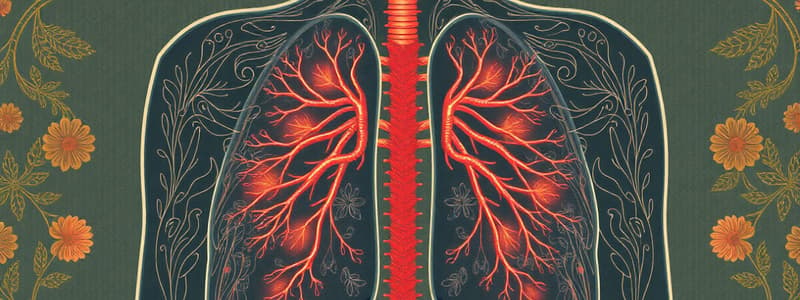Podcast
Questions and Answers
In a hypothetical scenario where a novel metabolic inhibitor selectively blocks the function of cytochrome c oxidase in human cells, which of the following immediate consequences would be most detrimental to cellular respiration?
In a hypothetical scenario where a novel metabolic inhibitor selectively blocks the function of cytochrome c oxidase in human cells, which of the following immediate consequences would be most detrimental to cellular respiration?
- Inhibition of complex I, preventing the electron transport chain and thus stopping ATP production
- Cessation of electron transfer to oxygen, causing a backup of electrons in the electron transport chain, resulting in a collapse of the proton gradient. (correct)
- Accumulation of NADH in the mitochondrial matrix, leading to feedback inhibition of glycolysis and the citric acid cycle.
- Uncontrolled proton pumping across the inner mitochondrial membrane, disrupting the proton motive force and ATP synthase activity.
Consider a sealed chamber containing respiring yeast cells and a carbon dioxide sensor. If the chamber's atmosphere initially consists of only nitrogen gas, and a small amount of glucose is introduced, what adjustment needs to be made to measure the production of carbon dioxide accurately?
Consider a sealed chamber containing respiring yeast cells and a carbon dioxide sensor. If the chamber's atmosphere initially consists of only nitrogen gas, and a small amount of glucose is introduced, what adjustment needs to be made to measure the production of carbon dioxide accurately?
- Introduce a buffer solution into the chamber to offset any changes in pH due to carbon dioxide production.
- Introduce a catalyst to accelerate both carbon dioxide production and oxygen consumption by the yeast cells.
- Continuously introduce nitrogen gas to maintain an anaerobic environment while measuring carbon dioxide production.
- Introduce a small quantity of oxygen to facilitate aerobic respiration while continuously removing any newly produced carbon dioxide. (correct)
The condition known as ______, often resulting from chronic tobacco smoke exposure, involves irreversible damage to the alveolar walls, reducing the surface area available for gas exchange and leading to significant respiratory impairment.
The condition known as ______, often resulting from chronic tobacco smoke exposure, involves irreversible damage to the alveolar walls, reducing the surface area available for gas exchange and leading to significant respiratory impairment.
emphysema
Imagine a scenario where a patient with a rare genetic disorder exhibits impaired chloride ion transport across the membranes of lung cells. Considering the physiological implications, which of the following secondary effects is most likely to exacerbate gas exchange inefficiencies in this patient?
Imagine a scenario where a patient with a rare genetic disorder exhibits impaired chloride ion transport across the membranes of lung cells. Considering the physiological implications, which of the following secondary effects is most likely to exacerbate gas exchange inefficiencies in this patient?
In human physiology, the Bohr effect describes the phenomenon where an increase in blood pH enhances hemoglobin's affinity for oxygen, facilitating oxygen uptake in the lungs and suppressing oxygen release in metabolically active tissues.
In human physiology, the Bohr effect describes the phenomenon where an increase in blood pH enhances hemoglobin's affinity for oxygen, facilitating oxygen uptake in the lungs and suppressing oxygen release in metabolically active tissues.
Explain why the production of carbon monoxide (CO) from incomplete combustion poses a greater threat to oxygen transport efficiency compared to an equivalent reduction in alveolar surface area caused by a condition like mild emphysema.
Explain why the production of carbon monoxide (CO) from incomplete combustion poses a greater threat to oxygen transport efficiency compared to an equivalent reduction in alveolar surface area caused by a condition like mild emphysema.
Match the following components of tobacco smoke with their primary adverse health effects:
Match the following components of tobacco smoke with their primary adverse health effects:
Flashcards
What is respiration?
What is respiration?
The process by which living organisms release energy from food.
Why respire?
Why respire?
To release energy from food, which powers life processes.
Where does gas exchange occur?
Where does gas exchange occur?
Lungs are responsible for the exchange of oxygen and carbon dioxide.
Inspired vs. Expired Air
Inspired vs. Expired Air
Signup and view all the flashcards
What is inspired air?
What is inspired air?
Signup and view all the flashcards
What is expired air?
What is expired air?
Signup and view all the flashcards
Harm of tobacco smoke?
Harm of tobacco smoke?
Signup and view all the flashcards
Study Notes
- Respiration in humans is essential for life.
Why Do Living Things Respire?
- Living things respire to release energy from food.
- This energy is used to carry out various life processes.
Studying Respiration
- Respiration involves the intake of oxygen and the release of carbon dioxide.
- Experiments can be conducted to demonstrate that carbon dioxide is produced during respiration.
Gas Exchange in Humans
- Gas exchange occurs in the lungs.
- Oxygen from inhaled air diffuses into the bloodstream.
- Carbon dioxide from the bloodstream diffuses into the air to be exhaled.
How Does Inspired Air Differ from Expired Air?
- Inspired air has a higher concentration of oxygen and a lower concentration of carbon dioxide compared to expired air.
- Expired air has a higher concentration of carbon dioxide and a lower concentration of oxygen compared to inspired air.
- Expired air also contains more water vapor and is warmer than inspired air.
Effects of Tobacco Smoke on Human Health
- Tobacco smoke contains harmful chemicals that can damage the respiratory system.
- Smoking can lead to lung cancer, chronic bronchitis, and emphysema.
- Secondhand smoke is also harmful to non-smokers.
Studying That Suits You
Use AI to generate personalized quizzes and flashcards to suit your learning preferences.
Description
Explore the essentials of respiration in humans, including energy release and gas exchange. Understand the differences between inspired and expired air. Learn about the lung's role in respiration and the effects of tobacco smoke.




